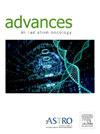Lumbosacral Plexopathy After Carbon-ion Radiation Therapy for Postoperative Pelvic Recurrence of Rectal Cancer: Subanalysis of a Prospective Observational Study (GUNMA 0801)
IF 2.7
Q3 ONCOLOGY
引用次数: 0
Abstract
Purpose
Data are lacking on the risk factors for radiation-induced lumbosacral plexopathy (RILSP) after carbon-ion radiation therapy (CIRT) for pelvic tumors, such as postoperative recurrence of rectal cancer. We investigated the incidence of RILSP and the associated dosimetric parameters using data from a prospective study of CIRT for postoperative pelvic recurrence of rectal cancer (GUNMA 0801).
Methods and Materials
The GUNMA 0801 study included 28 patients, of which we analyzed 20 without lumbosacral plexopathy prior to CIRT. The total dose of CIRT was 73.6 Gy (relative biological effectiveness [RBE]) in 16 fractions. The incidence of RILSP and parameters of the dose-volume histogram were evaluated for the lumbosacral plexuses. RILSP was graded according to the Common Terminology Criteria for Adverse Events version 4.0.
Results
Median follow-up was 24 months. The incidence of all RILSP (grades 1 and 2) and grade 2 RILSP was 22.5% (9/40) and 10% (4/40) of 40 lumbosacral plexuses in 20 patients, respectively, and no grade ≥ 3 toxicity was observed. Throughout the dose range, the volumes of the irradiated lumbosacral plexuses were significantly higher in patients with RILSP than in patients without RILSP (P < .001 for Dmax, D0.5 cm3 − D2 cm3, V20 Gy(RBE) − V70 Gy(RBE)). D2 cm3 and V50 Gy(RBE) were considered useful for receiver operating characteristic analysis. Cutoff values for RILSP were 73.82 Gy(RBE) and 33.2% for D2 cm3 and V50 Gy(RBE), respectively.
Conclusions
We demonstrated the incidence and predictive dosimetric parameters for RILSP after CIRT and showed that D2 cm3 ≥ 73.82 Gy(RBE) and V50 Gy(RBE) = 33.2% are cutoff values for predicting RILSP. These results would improve treatment plans using CIRT for patients with pelvic recurrences of rectal cancer.
直肠癌术后盆腔复发碳离子放疗后腰骶神经丛病变:前瞻性观察研究亚分析(GUNMA 0801)
目的骨盆肿瘤碳离子放射治疗(CIRT)后发生腰骶神经丛病(RILSP)的危险因素(如直肠癌术后复发)缺乏相关数据。我们研究了RILSP的发生率和相关剂量参数,使用的数据来自于一项直肠癌术后盆腔复发的CIRT前瞻性研究(GUNMA 0801)。方法和材料GUNMA 0801研究纳入28例患者,其中20例在CIRT前无腰骶神经丛病。CIRT总剂量为73.6 Gy(相对生物效[RBE])。评估腰骶神经丛RILSP的发生率和剂量-体积直方图参数。根据不良事件通用术语标准4.0版本对RILSP进行评分。结果中位随访时间为24个月。所有RILSP(1级和2级)和2级RILSP发生率分别为22.5%(9/40)和10%(4/40),40例腰骶神经丛中20例患者,未观察到≥3级毒性。在整个剂量范围内,有RILSP患者的腰骶神经丛体积明显高于无RILSP患者(P <;Dmax .001, D0.5 cm3−D2 cm3, V20 Gy(RBE)−V70 Gy(RBE))。D2 cm3和V50 Gy(RBE)被认为对接收机工作特性分析有用。RILSP的截止值分别为73.82 Gy(RBE)和33.2% (D2 cm3和V50 Gy(RBE))。结论我们证实了CIRT后RILSP的发病率和预测剂量学参数,并表明D2 cm3≥73.82 Gy(RBE)和V50 Gy(RBE) = 33.2%是预测RILSP的临界值。这些结果将改进使用CIRT治疗盆腔直肠癌复发患者的治疗方案。
本文章由计算机程序翻译,如有差异,请以英文原文为准。
求助全文
约1分钟内获得全文
求助全文
来源期刊

Advances in Radiation Oncology
Medicine-Radiology, Nuclear Medicine and Imaging
CiteScore
4.60
自引率
4.30%
发文量
208
审稿时长
98 days
期刊介绍:
The purpose of Advances is to provide information for clinicians who use radiation therapy by publishing: Clinical trial reports and reanalyses. Basic science original reports. Manuscripts examining health services research, comparative and cost effectiveness research, and systematic reviews. Case reports documenting unusual problems and solutions. High quality multi and single institutional series, as well as other novel retrospective hypothesis generating series. Timely critical reviews on important topics in radiation oncology, such as side effects. Articles reporting the natural history of disease and patterns of failure, particularly as they relate to treatment volume delineation. Articles on safety and quality in radiation therapy. Essays on clinical experience. Articles on practice transformation in radiation oncology, in particular: Aspects of health policy that may impact the future practice of radiation oncology. How information technology, such as data analytics and systems innovations, will change radiation oncology practice. Articles on imaging as they relate to radiation therapy treatment.
 求助内容:
求助内容: 应助结果提醒方式:
应助结果提醒方式:


